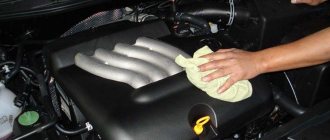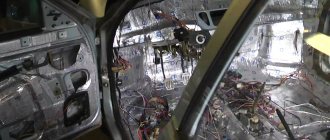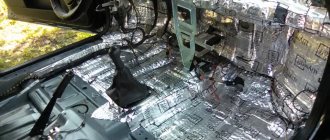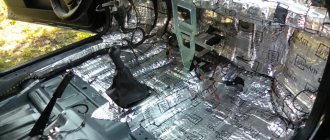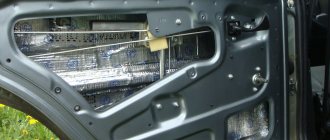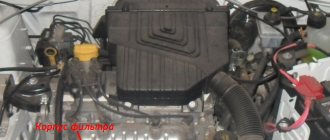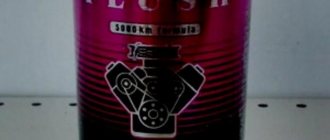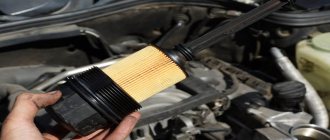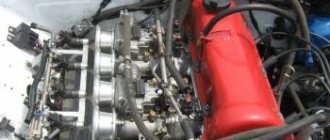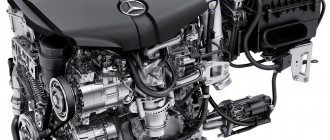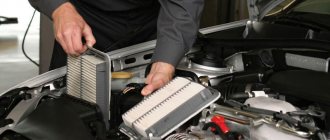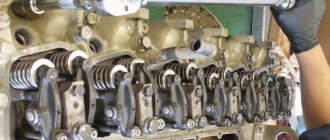A large-scale survey of motorists conducted several years ago about what irritates them most when using a car, gave many unexpected answers. One of them has become widely recognized as a strong irritant: excessive engine noise, especially on long trips. For many drivers, it constantly creates serious psychological discomfort, involuntarily unsettling them, preventing them from fully concentrating on driving, which, on top of everything, increases the likelihood of getting into an accident. Increased, painfully perceived noises often cause increased blood pressure, headaches, disturbances in the functioning of the hearing aid and other manifestations of deteriorating health. Since such a reaction is observed in almost all regions, it is necessary to comprehensively investigate this unpleasant phenomenon, determine its causes, ways to overcome it, and become familiar with exactly how engine noise insulation should be carried out, which will be useful to many drivers and passengers in practice.
How to soundproof the engine and engine compartment yourself.
Sound sources
The question about the sources of annoying sound is rhetorical: the noise most often comes from a running motor, and intensifies or acquires a repulsive sound background in the event of a malfunction of any of its parts or the whole unit. Their result can also be a wide range of different single or grouped sounds in the form of tapping, grinding, vibration, etc., which can be periodically repeated, becoming cyclical.
These annoying sound phenomena can also be recorded when the motor as a whole is working normally, but some of its parts are poorly secured or insufficiently adjusted. In addition, the sound effect sometimes occurs not only from a running engine, but also from mechanical problems occurring in the engine part, under the hood, underbody or in other places of the car. It happens that they are caused by even such a seemingly trifle as an insufficiently tightened nut. This is especially true for low-cost, mid-range, entry-level cars, as well as cars with a long service life and significant mileage on poor-quality roads.
We emphasize that it is unlikely that it will be possible to successfully soundproof the engine if you do not understand the true causes of excessive or unusual sound and do not eliminate them completely. Therefore, in all cases, it is necessary to carry out a careful step-by-step comprehensive inspection of the car, including its chassis, engine part, and the entire engine compartment, and after completing the inspection and identifying the reasons, begin soundproofing actions.
Why don't cars leave the factory with complete sound insulation?
Many car owners are wondering: why didn’t the manufacturer make good sound insulation of the car from the beginning? After all, if the car is of the lower and middle class, then there is either no soundproofing material at all, or its quantity is minimal.
The main reason for this is the manufacturer’s desire to save on insulating components, since each element of sound insulation will have to be spent. And if we take into account the volume of products produced, the cash costs of the car plant will be large.
The second reason is the manufacturer’s reluctance to devote time to installing soundproofing materials. All operations on the conveyor are scheduled to the minute, and equipping a car with high-quality noise insulation will require a lot of them.
The third reason is the extra weight (several tens of kilograms), which the complete “noise” adds to the weight of the car.
Although already in the process of creating a new model, at the stage of developing design characteristics, manufacturers seriously think about the issue of car sound insulation. To do this, the optimal mounting points for the exhaust system are calculated, the selection of engine mounts, supports, etc. The higher the cost of the car, the more serious the fight against external noise stimuli will be.
Due to the rapid motorization of Russia at the beginning of the new millennium, a great demand for noise and vibration insulation arose. In the mid-2000s, modern models of well-equipped, inexpensive cars appeared on sale. However, there was practically no factory sound insulation in them. According to the demand, a supply appeared in the form of various accessories and materials designed to provide additional noise and vibration insulation, which formed a separate market niche. Naturally, this gave impetus to the development of the service industry in this area.
Therefore, today soundproofing work is carried out both by private owners and official dealers. Some car owners do this themselves. The cost of soundproofing a car largely depends on the contractor.
There are two ways to install car soundproofing. The first involves the use of a ready-made kit, which includes a full set of necessary materials. In addition, there is a diagram of the car indicating the places where to glue and the sequence of work. Currently, there are very few such kits on sale. There is enough red tape with them, while the difference in cost compared to the work of specialists is small. Moreover, everything will depend on the quality of the manipulations performed.
Car noise insulation, performed by professionals using specialized materials combined in several layers, reduces the internal sound impact by up to 50%. If the work is carried out by the car owner himself, it will cost less than specialists. However, taking into account the time spent, possible errors in the process of installing sound insulation yourself (incorrect application, waste of material), the difference in cost will be insignificant.
How to make noise less
To effectively carry out work on insulating or reducing noise, it is necessary to initially resolve a fundamental issue: will the sound insulation of the engine compartment be sufficient, or is additionally required reliable sound insulation from the inside of the cabin, from the driver. Many people do not like the last option, since in this case, willy-nilly, you will have to remove the instrument panel and then mount it back, and this will take a lot of time, while taking away a significant part of the nerves. If this is done at a service station or other auto service center, their help may not be cheap. The driver must consider these obvious points, the need to work independently or with the help of professionals, based, obviously, on the main thing - not so much saving money (although this is an important issue!), but for the sake of maximum noise elimination.
Wheel noise protection
Wheels also generate some noise. It occurs due to resistance or rustling of the tread on the asphalt at speed. This is the second source of car noise after the engine.
Most cars do not have any form of sound insulation for wheel arches. Therefore, doing it yourself is necessary to get results. Operating procedure:
- Wash the surface of the arches until the dirt completely disappears. Dry.
- Degrease the surface. Apply anti-gravel. With standard protection, you do not need to apply this product.
- Apply vibration insulation. For pasting you need to apply mastic in 2-3 layers. Drying time between applications is up to half an hour. The ambient temperature during work is 20 degrees.
- Adhesive soundproofing layer. It is worth using a material based on foam rubber.
The work is not difficult. But arches are a problem area for many cars. In some cases, additional processing will be necessary, especially for representatives of the domestic automobile industry. A layer of mastic must be applied in strict compliance with the technology. This will allow you to purchase additional protection from dirt and reagents.
Anti-gravel provides protection for the anti-shumka itself. Technical fluids will not have a negative impact on protection in this case.
What is needed to install Shumka
To effectively soundproof an engine, you need to prepare not only all the necessary insulating materials, but also auxiliary ones, as well as a set of tools so that you don’t have to look for them when the soundproofing process is in full swing. First of all, you should have on hand:
- a heat hair dryer in which you can adjust the heating intensity;
- high-quality sharp scissors and a knife with strong handles;
- degreaser;
- several convenient spatulas and brushes;
- roller for rolling out the mixture.
To clean surfaces from dirt and all kinds of waste, a portable vacuum cleaner is also useful.
Where is the noise coming from?
First you need to inspect the motor (listen to its operation) to understand where the increased noise comes from:
The most common sources of excess noise are chains or their tensioners (if the engine has them) A worn fuel pump is noisy The engine may be noisy from low-quality fuel Also check the integrity of the engine mounts Listen and check the condition of the gearbox It is worth paying attention to many other engine elements that indirectly can make an additional contribution to the overall noise. Among them, the exhaust pipe (and the entire system) of the car deserves a separate topic, and specifically burnt-out mufflers or direct-flow pipes. Why do you think we spend so much time on the technical condition of your car? This is because without eliminating the sources of additional noise, subsequent fiddling with the sound insulation of the car will be simply pointless. The main way for the spread of noise from the engine is cracks, loud exhaust, vibration, uneven operation of the cylinders, malfunction of the fuel pump When inspecting the engine compartment, you should pay attention on the cracks (holes), holes leading into the cabin. Especially check the standard plugs and bushings. Because they usually forget to put them in place when installing amplifiers or stretching wires for the alarm siren. Close the hood and strongly pull the hood curtains (near the windshield), there is play. in this case, it should be absent. Do not neglect this simple check. We often encounter such a nuisance even on new cars of the BMW level. When something squeaks by ear, such a noise is often mistaken for a “dead” shock absorber. After this, it is worth carefully inspecting the front wheel arches in order to detect holes in the wheel arches. Surely you will find them. Through such holes, for example, brake hoses can come out. After this, go to the front doors of the car, then open the door, check the gap between the pillar and the door itself. In the gap, can you see the arch niche (see Soundproofing car arches different materials)? After this, carefully inspect the sealing rubber on all doors and along its entire length. This refers to the rubber band that should seal the door when closing. It is checked very simply. If your rubber band has traces of pressure on the entire surface, then everything is in order, however... Most often There is a situation when in one place there is a good clamp, but in another there is none. To check, we advise you to take a sheet of paper and insert it into the gap, then close the door. Pull the sheet, if you were able to pull out the paper, this means that there is no sealing I hope now you understand that sound insulation of the engine compartment on the engine side begins after a thorough inspection of the car and elimination of sources of increased noise and sealing problems
Features of sound insulation of the engine compartment
The most difficult part of the upcoming noise insulation work is rightfully considered by most experts to be the sound insulation of the engine compartment on the side of the engine, which has a large volume, since this is the insulation of the main noise sources, which are the engine and gearbox. Regardless of whether such processing of the car is carried out with your own hands or by experienced professionals, one of the initial stages will inevitably be vibration isolation of the engine compartment, given the close proximity of the engine shield to the engine, that is, its significant vibration load.
Selection of materials
To treat the floor, ceiling or doors, most motorists prefer to use the same soundproofing materials, which practically do not differ from each other in quality and properties. The procedure for treating the engine compartment with soundproofing materials is very similar to the procedure for using materials for wheel arches.
There are three main types of materials for soundproofing the engine and interior:
- vibration-absorbing;
- noise-absorbing;
- gaskets
Now let's take a closer look at each of these types.
Vibration-absorbing materials
Another name is vibration damping materials. Used to relieve load from the vehicle structure. Due to their properties, vibration-absorbing materials take part in damping body vibrations during operation of the vehicle’s suspension or engine.
Why are vibration-absorbing materials needed?
The main components of vibration damping materials are butyl mastic and an adhesive layer, which significantly simplifies the installation process.
Talitsa: Popular vibration-absorbing materials
| Material name | Description | Average cost (per sheet) |
| Bimast | A relatively new material with a two-layer base. Depending on the thickness, Bimast is divided into three types: “Bomb”, “Super” and “Standard”. | 500 rubles |
| Vibroplast | Durable vibration-absorbing material with aluminum coating. | 420 rubles |
| Vizomat | High-quality self-adhesive material, the main component of which is bitumen. | 400 rubles |
Sound-absorbing materials
Special materials used in car finishing. Designed for sound absorption. In its structure, this type of material is similar to foam rubber sheets. The quality and effectiveness of sound-absorbing materials depends on the thickness of the sheets. But when finishing, you should not experiment with the thickness of the layer, as this may cause certain difficulties when installing decorative parts or interior trim.
One of the most important layers when performing sound insulation
To perform soundproofing of the engine compartment, in addition to the basic materials, you need to take care of an anti-noise mask and liquid anti-gravity agent. You will find out why this is necessary in the instructions for performing soundproofing of a car engine with your own hands.
Table: Popular sound-absorbing materials
Only the integrated use of vibration and noise insulation materials will allow achieving maximum results. Some manufacturers offer materials that claim to provide complete insulation from noise, heat and vibration. You shouldn’t be fooled by advertising and rush to the store to buy a new product, because the interior of your car is not the place for unsuccessful experiments. It is better to spend a little more time and effort to perform high-quality sound insulation.
Padding materials
This type of material is used to eliminate creaks and noise. There is another name - “anti-creaking”. Sheets of gasket material are applied to the joints between panels in the cabin, on air ducts and other areas.
Another type of material is cushioning
Any material that eliminates squeaks at the joints between parts can replace the factory anti-creak. However, it is recommended to use only originals, as they will last you much longer.
Table: Popular gasket materials
| Material name | Description | Average cost (per sheet) |
| Madeline MELSI | An insulating material used to prevent interior squeaks and noise. Consists of non-woven fabric and anti-adhesive paper. | 720 rubles |
| Standard | Popular self-adhesive material from a domestic manufacturer. Impregnated with polyester. There is no need for heating for installation. Refers to budget options for anti-squeaks. | 170 rubles |
| Ultimate | It is produced in the form of tapes, rather than the usual sheets. Made from synthetic fabric. The tapes are covered with an adhesive layer. | 220 rubles |
Pros and cons of sound insulation
If all the necessary operations are carried out correctly, in full accordance with the recommendations of specialists, sound insulation of a car engine will give a positive effect even during its first test. However, there are certain risks that can nullify all the work done or significantly reduce its effectiveness. For example, during dismantling, due to haste or inattention, expensive parts of electrical equipment can be damaged, latches can be deformed, and the surface of plastic and other inserts can be damaged. Thus, there is a possibility of such damage during reverse installation, which will lead to deviations from the norm in the functioning of the climate control, problems with the on-board computer and other components of the car.
Therefore, both of these processes should be carried out as carefully and responsibly as possible. It is best if they are handled by experienced craftsmen.
How does noise enter the cabin?
The characteristic sound of a diesel engine finds many ways to penetrate into the cabin; cracks and glass are the best assistants for annoying sounds. If the engine is faulty, then half the interior may vibrate from its operation, usually due to malfunctions of the cylinders or fuel pump.
The importance of soundproofing is undeniable
It is necessary to get rid of the noise entering the cabin by any means. To do this, you must first inspect the plugs and bushings, which many drivers do not consider necessary to return to their place after installing the amplifiers
Next, you need to pay attention to the door seals: if they are compressed, then this is bad. If there are no traces, then it is necessary to achieve tightness of the doors in the closed position
It is easy to check the tightness of the door to the counter using a regular sheet of paper. The sheet is inserted between the counter and the door, if after opening the door the sheet turns out to be crumpled, then everything is fine with the insulation, but if the sheet remains intact, then this is not good.
Research at one of the technical centers revealed a similar problem with doors in many car models: Dodge, Mitsubishi, Hyundai and others. Even a small gap will be an excellent conductor for the tiresome sounds of wheels, engine or wind into the cabin.
Manufacturers' recommendations (different methods)
Floor soundproofing installation diagrams with materials:
| Shvi layer | Material | STP (thickness, mm) | Shumoff (thickness, mm) |
| 1 | Vibration isolation (vibration damper) | StP Aero Plus (3mm) |
Bimast Bomb Premium (4.2mm)
Shumoff Mix F (6.2mm)
VAZ sedan and hatchback:, 2110, 2112, 2114, 2115, Priora, Granta, Kalina
bitoplast – 1 roll, anti-creak tape – 1 roll, aluminum tape (aluminum tape) – 2 rolls.
VAZ coupe: 2112, 2113, Priora
bitoplast – 1 roll, anti-creak tape – 1 roll, aluminum tape (aluminum tape) – 2 rolls.
bitoplast – 1 roll, anti-creak tape – 1 roll, aluminum tape (aluminum tape) – 2 rolls.
In addition to the material itself, you will need
Technology for installing soundproofing materials
When you have already purchased everything you need and have carried out the preparatory work, you can proceed directly to the procedure of covering the engine compartment with sound insulators. You need to understand that our main task is to create a kind of capsule, and it should be as airtight as possible. Therefore, when applying insulating layers, strictly follow the technology so that as a result there are no unpleasant surprises that will negate all your efforts. So, let's do the following:
- degrease the surface of the engine compartment. This applies specifically to body elements. Engine noise insulation is a rather broad expression, since we do not affect the engine. The materials will be glued specifically to the body elements. When degreasing, do not use acetone or solvent. They only drive grease particles into the layer of paint underneath. And with the slightest heating, fats are pushed back to the surface of the paint. The cheapest and most effective remedy is white spirit. It can be purchased at every point where paint and varnish materials are sold;
- then you should arm yourself with a hair dryer. Without it, it is unlikely that it will be possible to lay the next two layers of vibration and noise-absorbing materials efficiently. There is no need to try to heat the sheets by leaving them in the sun on a warm day or on a radiator during the heated period of the year. If the material is not sufficiently heated, air bubbles will remain between it and the surface of the body or the previous layer. After a certain period of operation, this layer will completely fall off, which means there is no need to skimp on tools;
- Using a hairdryer, we warm up the elements cut from a single sheet and apply them to the degreased surface of the body. Using a rubber spatula or a special roller, firmly apply the vibration insulation to the metal surface of the body;
- then we heat the noise-insulating material with a construction hairdryer. We also carefully apply it to the previous layer with a rubber spatula. Without this tool, the sheets will not stick together tightly enough, and air bubbles will almost certainly form between them, which will only grow over time and lead to delamination of the materials;
- in the same way we heat and glue the third, protective layer.
The sound insulation of the shield between the engine compartment and the passenger compartment also requires attention. We glue it on both sides with the first insulating materials described above, not forgetting about degreasing the metal surface.
Materials
The DIY soundproofing process for any car requires the following materials:
- Bimast Bomb or Bimast Super (any analogues from other manufacturers are possible) are used to cover vibration insulation on both sides of the engine shield
- BiMast is a material from a new series of the best vibration-absorbing materials, which are based on bitumen plus mastic compositions
- BiMast material combines a set of the best qualities of traditional materials, plus it has a number of significant advantages
- The following areas in the car are recommended for treatment with BiMast (Bimast Bomb) material - the floors in the cabin and trunk, the dashboard (under the dashboard) on the interior side
Characteristics of Bimast
- Standard material thickness 4.2mm
- Its specific gravity is 6.0 kg/m2
- Has a mechanical loss coefficient of 0.40 units
- Designed for audio preparation of any car
- Gives maximum stiffening effect
- During installation, requires the use of an industrial (construction) hair dryer
- A significant (tangible) effect is achieved after treating more than 50 percent of the area
Splen or Accent
The sound insulation of the Priora causes a lot of controversy regarding the use of materials such as Splen and Accent:
- Splen - used to cover the hood, it is a vibration deflector plus serves as an additional layer of thermal insulation of the engine compartment
- Accent is a sound absorber, it reduces sound (absorbs) better than splenium, but does not have thermal insulation
- Vibration-isolating materials should be glued to the metal (prepared surface) as the first layer.
- It can be Vibroplast Gold or Bimast Bomb
- The second layer is sound-absorbing material
- Let's take a closer look at this point
- Let’s say right away that accent and splen are materials of different types.
- Splen is more of a heat insulator that has sound-reflecting properties (it reflects sound); sound-absorbing materials are more suitable for sound insulation
- However, the very low price of splen has led to the fact that it is used and actively used in car sound insulation, even at the highest level stations
- The accent is a sound absorber, absorbs and destroys mid-frequency noise
- Therefore, when comparing Spleen with Accent as noise absorbers, Accent will be much more effective than insulating Spleen, and testing by wrapping a mobile phone in the material is a deception
- “How can this be,” seasoned specialists are often indignant, “They always made noise with splenium, and it’s normal!”
- Previously, there was no such range of different materials
- First there was Izolon, which came to the automotive industry from the construction field (see Construction sound insulation for cars takes place), which was suitable for sound insulation of cars
- After the craze for Spleen, 10 years later they don’t want to notice more modern, and of course more effective sound absorbers, for example Accent or Bitoplast
Where to begin
First of all, many people ask questions about the advisability of the soundproofing procedure specifically on the engine side in the engine compartment.
There is an opinion that this is a completely useless event. And supposedly there is no meaning in it. But this is said mainly by those who have not felt the difference between cars with and without sound insulation, or who initially drive a car that has high-quality and efficient noise insulation from the factory. In the second case, I really don’t see the point in further insulating the engine compartment. But this occurs mainly on expensive and new cars. Owners of older and cheaper cars are less fortunate.
Cars that have been in use for more than one year, produced more than 10 years ago, usually have high noise and vibration from the engine. And even when running at idle.
And you shouldn’t blame only diesel engines. Gasoline engines also vibrate a lot and require additional noise.
The noise emanating from the engine irritates the driver, interferes with concentration, prevents him from fully enjoying music, and distracts him from driving. Noise is also a danger to the hearing organs.
It is equally important to get rid of vibrations. Soundproofing won't help here
But a special heat-resistant engine cushion will be an ideal solution to this situation. The pillow has the necessary combination of rigidity and elasticity, which gives it the ability to dampen vibrations. A mount is mounted under the engine. These elements take the brunt of the impact and the load. For added comfort, you can consider installing air bags in the springs, which also brings great benefits.
Purchasing materials for the engine compartment noise is not a problem. It is much more important to use their properties and capabilities correctly.
Processing procedure
The price of all assembled components is definitely lower than the cost of professional sound insulation services. After all, you still have to pay extra for the work.
By following a certain sequence, following the instructions and adhering to the rules, you will be able to cope with the task yourself.
The procedure can be described as follows:
- Since this is the engine compartment, it also includes the hood. It's better to start with him. First, the structure is removed and cleaned of dust, dirt and rust. Next it is degreased. This needs to be done with all body elements to which Shumka will be glued;
- Surfaces must be as dry as possible. Therefore, do not be lazy to wipe them with a rag, reaching to each cavity;
- Make patterns from cardboard, then cut out pieces of soundproofing material from them;
- First, a vibration-absorbing material is applied to the metal;
- The piece is cut out and applied to the surface, rolling it in parallel using a special roller. You can't just glue it by hand. The quality and effect will be lost;
- Use strictly materials with heat-resistant film, since the engine gets hot, and a product that is not resistant to high temperatures may cause a fire;
- It is definitely recommended to stick a layer of foil. It additionally reflects heat and protects the Shumka from overheating and damage;
- Sound insulation can be glued under the factory Shumka, or completely replaced with madeline;
- When covering the engine compartment, follow the same rules. To remove or not to remove equipment is a purely individual question. It all depends on being able to access the interior panels and bodywork around the engine.
Bimast or Vizomat come first because they act as vibration-isolating materials. You can already use Splen, Madeline or Accent behind them.
If you get too confused, you can even dismantle the engine, tape everything under it, and then put it back in place. But usually this is an unnecessary event that requires additional time and effort. Often it is enough to remove attached and easily dismantled equipment. Since the motor is located in the center, it usually does not interfere with the wrapping.
Have you ever had to carry out soundproofing from the engine compartment yourself and what secrets can you share with us?
